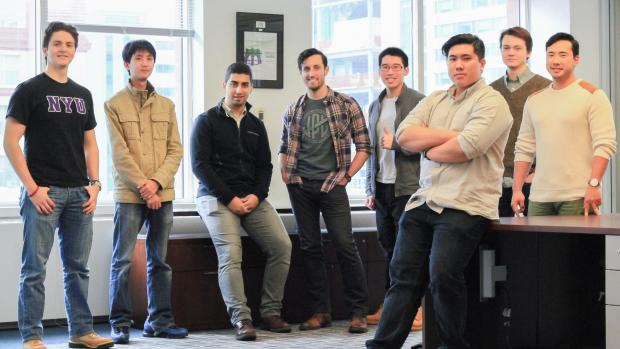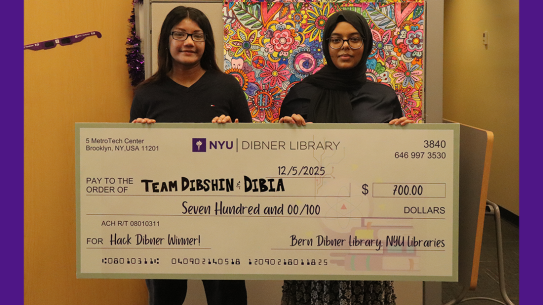Tandon Team Advances in International Hyperloop Design Competition
NYU's Hyperloop team to build and test prototype on SpaceX’s test track

“This is possibly the coolest thing you could ever be doing as an undergraduate engineer,” Darren Yee asserts.
Yee is the captain of NYU’s Hyperloop team, and he is recruiting fellow students but not exaggerating the groundbreaking task that will face them: The Tandon team has been selected to build a pod meant to speed freight, and eventually passengers, at more than 700 miles an hour through a visionary transportation system known as the SpaceX Hyperloop.
The Hyperloop is a ground transportation system envisioned by Elon Musk, the founder of SpaceX and Tesla Motors, as magnitudes faster, safer, and more sustainable than automobiles or trains. He imagined a system of low-pressure tubes elevated high above the ground, in which the pods would be surrounded by a cushion of air—think of a puck gliding over an air hockey table—and propelled by a series of magnetic accelerators.
To speed the system’s development, he recruited industry partners and announced a competition, inviting university teams to design and build working pods, which would then race on a one-mile test track to be erected near SpaceX headquarters in Hawthorne, California.
More than 120 teams from schools around the world converged on Texas A&M University at the end of January to display their designs and attempt to win a coveted spot to race in Hawthorne. “Most of the teams had at least 20 to 30 members,” Yee recalls. “So with just six of us from Tandon, it felt like a real David-and-Goliath situation.”
Armed with a design so unusual that it caused a buzz in Texas, Slate, as they dubbed their pod, had little in common with the sleek, futuristic conveyances for humans and cargo proposed by most of the others. A simple rectangular platform, it hardly seemed like the stuff of science fiction.

A rendering of "Slate," the hyperloop pod designed by a team of NYU Tandon students
That was exactly the point, Yee explains. Their design is imminently practical and allows for a large measure of collaboration and entrepreneurial development. The team, which is seeking corporate sponsors, envisions Slate initially carrying only freight, which can be loaded onto the platform in any configuration. “That gives us a twofold advantage,” Yee says. “First, you have to consider that every new technology engenders a certain amount of distrust and fear until it’s proven safe. Consumers will be able to see that the Hyperloop carries freight with no problem and might then be more willing to use a passenger pod. And because we envision this as a modular system, companies could collaborate in designing and building those passenger pods.”
~ Dean Sreenivasan
Yee credits his Tandon professors with not only instilling in their students an ethos of hard work, creativity, and innovation, but with providing invaluable guidance during the design process. The team has worked closely with their main advisor, Associate Professor of Aerospace Engineering Iraj Kalkhoran, as well as with others, but hopes to seek out more professors to aid in their efforts moving forward, as they ready a working model of Slate for its debut in California.
“This is exactly the type of project in which we want Tandon students to participate,” Kalkhoran says. “It allows them to use their problem-solving skills and implement our School’s educational philosophy of ‘invention, innovation, and entrepreneurship’ to design and engineer what could be the future of ground transportation. That the members of Tandon’s great multidisciplinary team are volunteering so much time and effort to tackle this important task illustrates their dedication and drive.”
Dean Katepalli R. Sreenivasan praised the team: “The students have displayed remarkable initiative, inventiveness, and drive in this exciting, first-of-its-kind competition, and their practical yet visionary design exemplifies the best of Tandon engineering. While we cannot all be with them at the California test track this summer, we will certainly be there in spirit, rooting them on as they represent our school and our city.”
In addition to Yee, the team includes mechanical engineering majors Benjamin High, Keith Gildea (who has already lined up a job with NASA post-graduation), and Philippe Sabbagh; electrical engineering majors Nick Molinski (who was offered a SpaceX interview while in Texas) and Xi Tang Zhao; Christopher Lysiuk, who is majoring in business and technology management; and computer science major, Jin Yan Ruan.
“We’d love to get some more younger students involved,” Yee says. “This is an opportunity to not only work on a potentially transformative project and compete on a global level, but it could ultimately lead to great internships and jobs.”
For more information, visit NYU Hyperloop, or contact Yee at yeedarrens@gmail.com.




